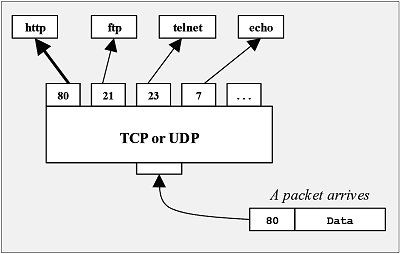
| Home : Course Map : Chapter 13 : |
|
Ports
|
| JavaTech |
| Course Map |
| Chapter 13 |
|
Network
Overview |
| About
JavaTech Codes List Exercises Feedback References Resources Tips Topic Index Course Guide What's New |
|
While the IP address will get the packet to the right computer, how does the packet get to the right program? A computer might have:
The Port number is the key for organizing all of this. The packets are guided to the correct program by the operating system according to the port number as indicated in this diagram:.
The port is a 16-bit number. It is occasionally seen on Web addresses: http://www.someplace.com:80/ where 80 is the default for the HTTP server. Nowadays the port number is seldom included in the URL since the default is almost always used. Various applications using particular protocols use standard port values as shown in tthe above diagram. Unix machines reserve ports 1-1023 for standard services. Windows machines do not restrict the use of these ports but to make your Java programs portable, it is wise to use port values above 1023. One type of firewall assigns port numbers to the machines behind its shield. Incoming packets all go to the same IP address but with different port numbers according to the machine they are destined for. This both reduces the exposure and accessibility to the machines and reduces the need for universally unique IP numbers. Behind the firewall, the local addresses can be the same as in other LANs since the LANs are isolated from each other. This is one of the reasons that four bytes remain sufficient for the internet despite the explosion in the number of devices with IP addresses. (Nevertheless, a sixteen byte version of IP addressing called IPv6 will gradually take over.)
Latest update: Dec. 8, 2004 |
